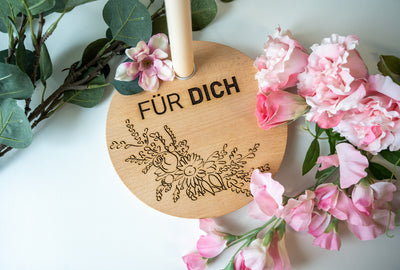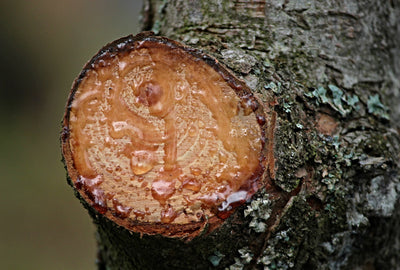Cherry wood is considered a noble wood that has many uses. The natural material comes in different colors , ranging from light yellow tones to dark red and brownish shades with greenish stripes. Cherry wood is not only popular because of its color. The material also finds numerous buyers due to its smooth surface, durability, fine grain and elastic properties.
Cherry wood: origin and types

Cherry wood comes from trees of the Prunus genus, especially the European bird cherry (Prunus avium), which is also known as sweet cherry. The tree species, which grows to a height of 25 meters and can live up to 100 years, is widespread in Europe and also occurs naturally in western Asian countries. Cherry wood is prized for its beautiful colour and grain and is often used to make furniture, wood paneling and craft items. You can also find the wood of the common bird cherry (Prunus padus) commercially. The species, which is mainly found in Europe, gets its name from its white flowers arranged in clusters. The wood is less durable than bird cherry, but can also be easily processed and used for visually appealing workpieces such as walking sticks. The late-flowering bird cherry (Prunus serotina), which comes from North America, is often sold under the name Black Cherry and helps to meet the demand for cherry wood in this country. Compared to the European species, the heartwood is slightly darker. Bird cherries produce bitter-tasting fruits, which means that their use as a fruit tree is not a priority.
Properties of cherry wood
Cherry wood is medium-weight and has good strength and elasticity properties. The density of the material is between 520 and 700 kilograms per cubic meter. Cherry wood is considered a medium to hard wood that is easy to shape. The swelling is comparatively low and there is a high resistance to damage. Particularly noteworthy is the colour and grain of the material. Cherry wood impresses with a different colour spectrum of its sapwood and heartwood. While the outer layers appear in light yellow tones, the interior becomes reddish-brown with occasional greenish streaks. The heartwood continues to darken over the life of the tree. The fine grain distinguishes cherry wood from mahogany, for example, which can appear similar in colour. Since cherry wood consists of uniform fibres, it is ideal for interior design and for surfaces on furniture. The material is not suitable for outdoor use because cherry wood is not weather-resistant and is susceptible to parasites.
Uses of cherry wood

The areas of application for cherry wood are diverse. Due to its properties and relatively low availability, the material is traded as a valuable material rather than as fuel. Cherry wood is mainly used:
- for wall and ceiling panelling
- for parquet
- in furniture manufacturing
- for tool handles
- for building musical instruments
- for the production of jewellery and sculptures
Cherry wood is used to make parquet floors and cladding ceilings and walls. The natural beauty of wood gives rooms a warm and inviting atmosphere. Due to its fine grain and easy-to-work properties, the material is well suited for woodworking and carving. You can easily incorporate detailed decorations and give your interior a personal touch. Cherry wood is also often used to make high-quality furniture. It is characterized by a lively grain, a great colour and a smooth surface, which can make the piece of furniture an elegant, unique piece. Cherry wood furniture is popular in both traditional and modern designs. Some musical instruments, especially valuable string instruments such as violins and cellos, may be made of cherry wood. The wood is valued for its acoustic properties and its ability to produce a warm sound. In addition, the handles of hammers and other craft utensils are often made from the robust material. The excellent appearance and easy processing make the material also interesting for jewellery making and fine art.
Proper care and treatment of the material

Caring for cherry wood is important to maintain its beauty and extend its lifespan. Remove dust deposits regularly with a soft, dry cloth. Harsh cleaning agents and a lot of moisture are taboo as they can damage the wood. Therefore, wipe up spilled liquids immediately. To prevent warping and cracking, you should keep cherry wood protected from extreme temperature fluctuations and high humidity. A polish can be used to ensure that you can enjoy your interior design and your objects made of cherry wood for a long time. You can use oils, wax and mobile polish for this. Make sure to choose a product that is suitable for wooden surfaces. In our online shop you will find a suitable wood care set with which you can treat and optimally care for anything made of cherry wood. You can read more tips in our guide to wood care.
Cherry wood with sustainability in mind
Cherry wood is considered a relatively sustainable wood option, provided it comes from sustainably managed areas. If you want to use the material for interior design and other projects on a large scale, you should prefer wood from Europe. The transport routes are shorter here, which has a positive effect on your CO₂ footprint. In addition to reducing environmental impact, you can also improve the socio-economic conditions of the respective community by using locally grown cherry wood. By purchasing FSC-certified wood, you ensure that the material is harvested in a nature-friendly manner and with minimal use of pesticides. The seal is also intended to ensure that the mining of the material does not contribute to the destruction of the jungle.
The tradition of cherry wood

Cherry wood has been used in furniture making since the 16th century. As one of the most beautiful local furniture woods, the cherry tree has asserted itself alongside the walnut tree as a furniture and furnishing material over many different eras. The material was increasingly used, particularly in the Art Nouveau, Biedermeier and Louis Seize periods. Be it cupboards, tables, chairs or chests of drawers - there is hardly any piece of furniture that is not made of wood. Musical instruments such as violins have always been made from cherry wood. Instrument makers appreciate the warm sound that comes through the wood.
Cherry wood: current trends
Cherry wood remains a popular material for furniture making, particularly for high-quality, handcrafted pieces. The demand for sustainable and natural materials has also led to increased interest in cherry wood furniture. Interior designers are giving wood a new lease of life by increasingly incorporating it into their designs. A parquet made of cherry wood is in demand and not only popular among well-earning people. Cherry wood also continues to be used for arts and crafts projects. The unique grain and colour of the wood make it an attractive material for creative work. With the Mr Beam laser cutter, you can process cherry wood first-class and design it as you wish for your project. Cut the wood perfectly with the laser cutter and provide it with detailed engravings for an individual touch.
Conclusion on cherry wood
Whether it's a piece of furniture, flooring or a string instrument - cherry wood has numerous advantageous properties that make the material a sought-after material for various types of use. The aesthetic and physical qualities of the material speak for themselves and have secured the material a permanent place among woods for certain uses over the past centuries. The user is offered high resilience with easy processing and an attractive appearance. In addition, cherry wood scores points compared to many other types of wood due to its better sustainability.



